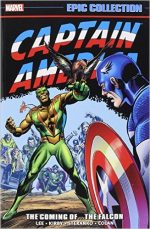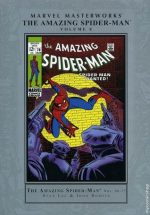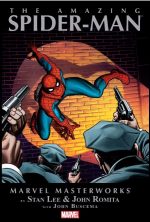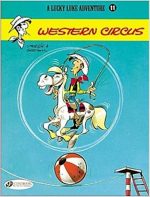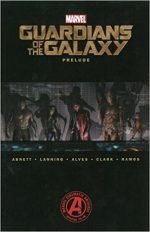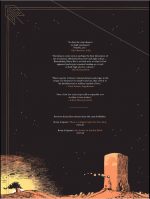
By Doug Wildey (IDW)
ISBN: 978-1-61377-210-2Â Â Â Â Â Â Â Â Â Â Â Â Â Â Â Â Â eISBN: 978- 1-62302-476-5
There have been a lot of Western comics over the years created by Americans and other nations. Most were banged out as commercial fodder to feed fashion during periods when more mainstream media celebrated a periodic re-emergence of the genre. Rio is most definitely not one of those.
Working at his own pace for his own pleasure over many long years and virtually isolated from the mainstream comics world, the late Doug Wildey – famed animator (Johnny Quest) and comic strip artist (his Outlaw Kid strips for Marvel were a rare high-point during the 1950’s Western boom following the rise of TV ownership in the USA) – produced an iconic and elegiac immortal character.
After a meandering trail of appearances at Eclipse, Comico and Marvel, the wanderer most recently settled at IDW for this glorious collection: far more a serious art book than simply collection of wondrous comics storytelling.
Almost the entirety of this stupendous compendium is shot from Wildey’s immaculate multi-media original art with corrections, amendments and every instance and evidence of the creator’s interaction with the page left for aficionados to enjoy. No flattening bowdlerisation of the print process here: Think of it as a gallery visit in your own hands…
The content is all Wildey’s published stories, one entire unpublished tale and a final almost-complete saga the artist was working on when he died. As he was a rather mercurial cove Wildey skipped about a story, wrapping up pages as the whim took him, so the missing parts are there in spirit too: as roughs, sketches, pencils or script and layout designs. It’s a fascinating glimpse of a born raconteur and relentless perfectionist plying his trade…
Also included are dozens of sketches, pin-ups and other associated images all given weight and context through a loving appreciation by Mark Evanier in his Introduction. What more can a fan want?
Well, obviously, a damned fine read…
An old gunfighter and badman in the heydays of the Wild West, Rio is rangy loner wandering the country just ahead of creeping civilisation, trying to live the rest of his life as best he can as the end draws near.
The saga began as a serial in the early 1980s in Eclipse Monthly, during the early days of American Comics’ Direct Market revolution before being collected into an album-sized compilation and assorted reprints since.
In ‘The Hide Butchers’ the iconically world-weary “tall rider†is engrossed on a tricky and dangerous mission. Offered a full pardon by President Ulysses S. Grant in return for stopping the decimation of the Buffalo herds by “Sporting Specialsâ€, Rio is in Wyoming Territory vainly attempts to reason with the Railway boss Dorsey.
These train excursions, wherein customers could slaughter the animals from the comfort of their seats, nearly wiped out the Buffalo, and consequently almost starved the Indians who lived off them to their own extinction.
Deemed a threat to profits, the loner is promptly framed for murder by the bigwig’s hirelings – the Grady Parrish gang – and must hunt down a small army of gunmen before he can know any real peace…
That hunt begins in ‘Satan’s Doorstep’ wherein the trail leads into Apache country and a doomed clash with a cavalry troop led by a glory-obsessed fool who thinks he’s the next Napoleon Bonaparte…
Sole survivor of that desert confrontation, Rio picks up his quarry’s trail in Endsville, Wyoming and quickly crosses the border to an enslaved Mexican town turned into a ‘Robber’s Roost’ by the bandits he’s chasing.
To pass the time the sadistic brutes play a murderous hunting game with the citizens, however when Rio is captured he finds a way to turn the tables against them…
Wildey was a master storyteller and a Western Historian of some note. His art graced many galleries and museums, but his greatest achievements can be seen here, where his artistry brings that lost and fabled world briefly back to vibrant life, in spirit as well as look.
Wildey switched over to colour in his own unique style and a more luscious and painterly colour palette, transferring his iconic lone rider from the wilderness to the very borders of the creeping Civilisation he so patently abhorred in a sequel to his original tale of ‘Mr. Howard’s Son’…
Now finally pardoned by President Grant, Rio is invited to become sheriff of Limestone City, a burgeoning metropolis less than 100 miles from Kansas City yet somehow a town with no crime! Whilst considering the offer, he finds old friends already living there; two of the most infamous outlaws in history who – with their families – are living quietly as respectable, if incognito, citizens of the progressive paradise.
However, after a botched kidnapping and speculative bank raid exposes the retired outlaws, human nature and petty spite quickly lead to disastrous chaos and a spiral of bloody tragedy which the new lawman is ill-equipped and much disinclined to help with…
Next up is ‘Hot Lead for Johnny Hardluck’ as Rio meets a young Dutch kid hardened by exploitative mine work who has chanced upon a fortune. After winning a huge diamond at poker the boy heads for San Francisco, unaware that the sore loser has hire a pack of thieves to restore the stone at all costs…
Happily, Rio is working as stagecoach guard on the route the kid follows but even after the fireworks are over, the danger and bloodshed isn’t…
Another brush with famous gunmen informs ‘Red Dust in Tombstone’ as Rio meets up with Doc Holliday and his pals the Earp brothers. Trouble is brewing in town and tensions are high but Wildey smartly shows us a telling side of all concerned that movies have not…
Wrapping the narratives up with the tantalising promise of what might have been, ‘Reprisal’ is an unfinished masterpiece of cowboy lore as the lone rider saunters into a brewing crisis on the border. Bandits are raiding ranches but when the wanderer uncovers a scam with soldiers selling gunpowder to the outlaws the situation quickly escalates into savage tragedy…
The wagon train of wonders closes with an epic visual treat as ‘Doug Wildey’s Rio Gallery’ re-presents covers, evocative colour illustrations, sketches and model sheets to delight every fan of the genre or just great illustration.
Gripping, authentic, and satisfyingly mythic, these tales from a master of his subject and his craft are some of the best westerns America has ever produced and some of the most sublime sequential art every set to paper.
© 2012 Ellen Wildey. All Rights Reserved. Introduction © 2012 Mark Evanier.


